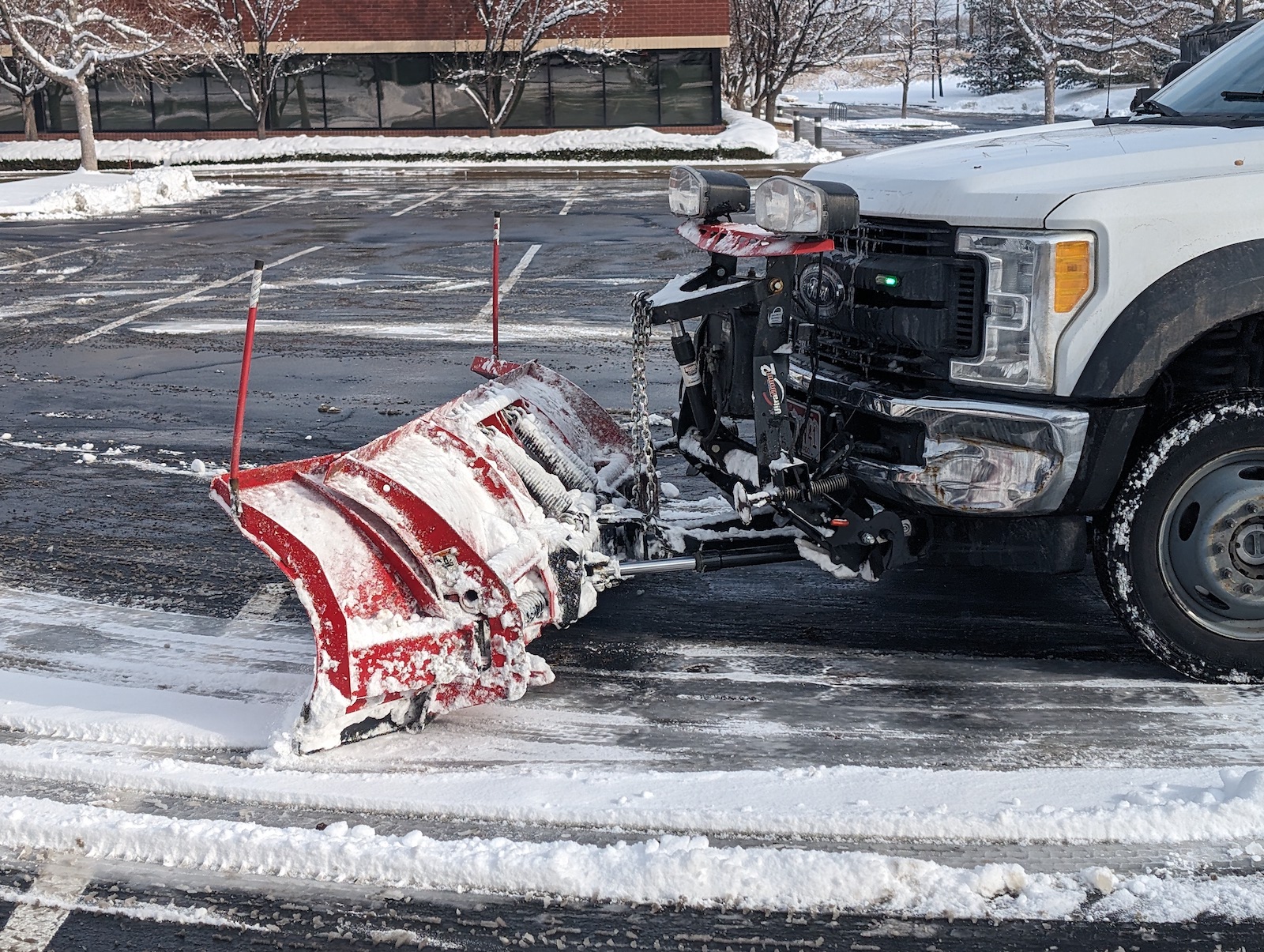
5 Ways to Reduce Slip and Fall Risks on Your Commercial Property this Winter

Winter in Colorado brings a beautiful snowy landscape, but also the challenge of keeping your commercial property safe from slips and falls-every property manager’s nightmare.
Effective snow and ice removal is crucial to avoiding these accidents and ensuring safety. Going the extra mile not only helps protect employees, customers, and visitors but also builds your reputation as a community leader who takes safety serious.
In this blog we’ll explore five essential tips to keep your commercial property safe during the winter months.
Learn more about:
Regular Snow & Ice Removal Services
Deicing Materials
Safety Inspections
Drainage Solutions
Adding Signage
How to Avoid Slips and Falls in Winter? Start with Regular Snow & Ice Removal Services
In Colorado, our sometimes harsh winter conditions make timely snow and ice removal essential for minimizing slip and fall risks. Prompt removal prevents snow from compacting and freezing, maintaining a safer environment.
Regularly scheduled snow removal ensures consistent management of snow and ice. Key steps include:
- Monitoring weather conditions: Stay updated on forecasts to anticipate snow and ice events instead of reacting to them after snow has fallen.
- Pre-Treatment: If possible, apply anti-icing treatments before snowstorms.
- Post- Storm Clean-Up: Schedule follow-up visits for additional snow or ice and to combat refreeze.
Consider Snow Pile Relocation
One often overlooked aspect of snow removal is the proper relocation of snow piles. Improperly placed snow piles can lead to melting and refreezing, creating ice patches that pose as a slip hazard. Identify areas where snow can be safely piled without obstructing pathways or parking spaces.
If piles get too large for your property, consider moving snow offsite. Avoid drainage paths and nsure snow piles are not places in areas where melted water can flow back onto walkways and freeze. Finally, check snow piles periodically to manage their size and relocate them if necessary.

Early Morning Deployment
To maximize commercial snow safety, crews should be deployed early in the morning hours. This ensures that snow and ice are cleared before customers and employees arrive, reducing the risk of slips and falls. Early deployment allows crews to:
- Preempt Snow Accumumlation: Remove snow as it falls to prevent compaction and ice formation.
- Ensure Accessibility: Make sure walkways, entrances, and parking lots are safe and accessible by the start of business hours.
- Provide Continuous Maintenance: Perform ongoing maintenance throughout the day to manage any additional snow fall or ice formation.

Provide Commercial Snow Safety by Using De-Icing Materials
It is essential to prioritize using effective deicing materials that outperform traditional rock salt, which tends to be ineffective in our climate. The products you select should be treated with additional elements to expedite melting, especially when exposed to sunlight. Here’s what we recommend for superior deicing products:
- Parking Lots: For parking lots, we use Rapid Thaw, a product that combines Sodium Chloride with Potassium Chloride and Magnesium Chloride. This mixture not only accelerates the melting process but also has a distinctive orange appearance for easy identification.
- Sidewalks: On sidewalks, we apply a Sodium Chloride product treated with Calcium Chloride and Magnesium Chloride, dyed purple for visibility. This sidewalk product is also pet-friendly, ensuring the safety of animals that may come into contact with it.
- Liquid Magnesium Chloride: For pre-treatment, we use Liquid Magnesium Chloride, an anti-icing agent that is highly effective before freezing rain or snow begins to fall. Applying this product ahead of a storm helps prevent ice from forming, making subsequent snow removal easier and more efficient.
In addition, to help facility managers maintain safe conditions during and after snowstorms, we provide buckets of ice melt near entrances. These buckets are regularly stocked throughout the season, ensuring that ice can be mitigated even when our crews our not onsite. This proactive approach allows for immediate action to prevent ice buildup and reduce slip and fall risks.

Other Snow Removal Tips:
- Use Appropriate Equipment: Utilize commercial-grade snowplows, blowers, and shovels. This equipment is specifically designed to remove snow from large areas.
- Clear Walkways and Entrances: Prioritize high-trafic areas such as walkways, entrances, and parking lots to ensure safe access. These areas need the most focus because it is where slip and falls most frequently occur.
- Inspect and Maintain Equipment: If you do not hire out your commercial snow removal, be sure to regularly check and maintain your snow removal equipment to ensure it operates effectively during snow events.
How Can I Improve Winter Safety for My Commercial Business? Perform Regular Property Inspections
Regular inspections are crucial in maintaining a safe commercial space during the winter months. After each snow event, a thorough property inspection should be conducted to ensure top-quality snow removal services. These inspections should verify that snow piles are properly pushed up and do not block access points, sidewalks are cleared side-to-side, and there is no excess ice melt product left behind. Additionally, your property should be inspected for damage to ensure everything is in good condition. This diligent oversight helps prevent slip and fall accidents, providing a safer environment for employees, customers, and visitors.
Commercial Snow Safety Tip 4: Install Proper Drainage Solutions
Proper drainage can help your commercial property be safer in the winter months. Drivers and shovelers should avoid piling snow around drainage channels and basins, ensuring that melting snow can flow freely. This is vital because any water that doesn’t drain effectively can pool and re-freeze, especially overnight when temperatures drop.
Factors like snow water content, temperature fluctuations, and sun angle can all impact re-freeze conditions. To mitigate these risks, focus on keeping drainage channels open for optimal water flow. Because water can not be ‘moved’ it is important to ensure property drainage channels before snow falls. If standing water persists, having buckets of ice melt onsite allows you as a property or facility manager to quickly treat icy patches.

Try Adding Commercial Snow Safety Signage
Adding signage is an effective measure to enhance safety and prevent slip and fall accidents. Try installing signs that alert individuals to the potential presence of ice, such as “Caution-Icy Conditions May Exist”. Thse signs serve as a visual reminder to proceed with caution.
Some signs can even change color when temperatures drop low enough for ice to form, providing an additional layer of awareness.
How to Select Reliable Snow Removal Services in Boulder, CO
Ensuring the safety of your commercial property during winter in Colorado can be daunting, but you don’t have to tackle it alone Consider hiring a professional snow removal team, like LID Landscapes, who specialize in comprehensive snow and ice management.
With expert services, advanced equipment, and proven deicing solutions, LID Landscapes can help you maintain a safe environment and minimize slip and fall risks.

Ready to partner with LID Landscapes to increase your commercial property’s safety this winter? Fill out our contact form today to discuss snow and ice mitigation.

Scott Natter
